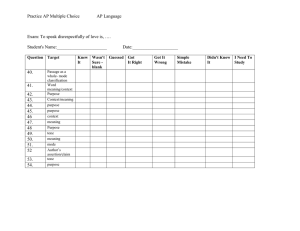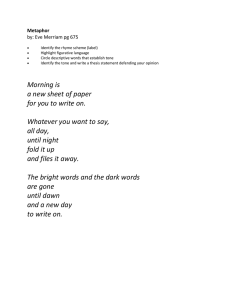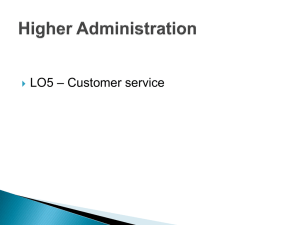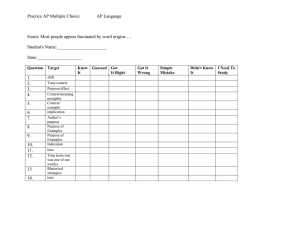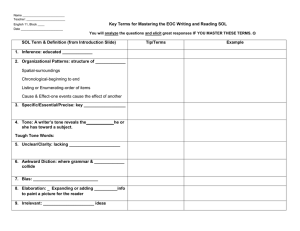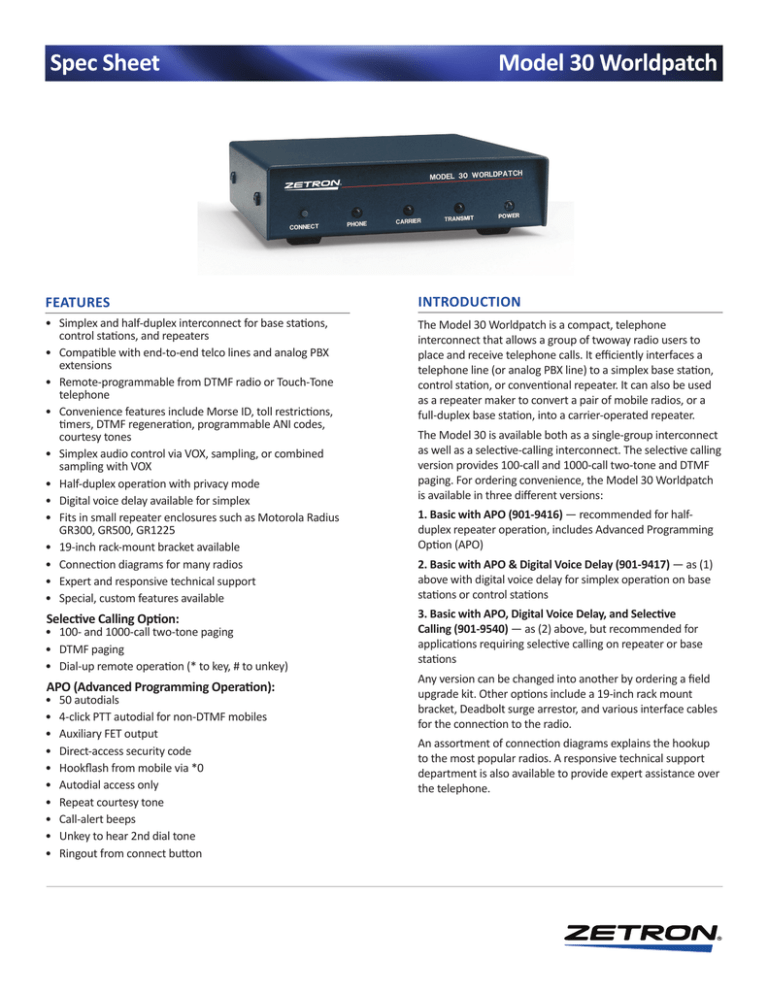
Spec Sheet
Model 30 Worldpatch
FEATURES
INTRODUCTION
• Simplex and half-duplex interconnect for base stations,
control stations, and repeaters
• Compatible with end-to-end telco lines and analog PBX
extensions
• Remote-programmable from DTMF radio or Touch-Tone
telephone
• Convenience features include Morse ID, toll restrictions,
timers, DTMF regeneration, programmable ANI codes,
courtesy tones
• Simplex audio control via VOX, sampling, or combined
sampling with VOX
• Half-duplex operation with privacy mode
• Digital voice delay available for simplex
• Fits in small repeater enclosures such as Motorola Radius
GR300, GR500, GR1225
• 19-inch rack-mount bracket available
• Connection diagrams for many radios
• Expert and responsive technical support
• Special, custom features available
The Model 30 Worldpatch is a compact, telephone
interconnect that allows a group of twoway radio users to
place and receive telephone calls. It efficiently interfaces a
telephone line (or analog PBX line) to a simplex base station,
control station, or conventional repeater. It can also be used
as a repeater maker to convert a pair of mobile radios, or a
full-duplex base station, into a carrier-operated repeater.
Selective Calling Option:
3. Basic with APO, Digital Voice Delay, and Selective
Calling (901-9540) — as (2) above, but recommended for
applications requiring selective calling on repeater or base
stations
• 100- and 1000-call two-tone paging
• DTMF paging
• Dial-up remote operation (* to key, # to unkey)
APO (Advanced Programming Operation):
•
•
•
•
•
•
•
•
•
•
50 autodials
4-click PTT autodial for non-DTMF mobiles
Auxiliary FET output
Direct-access security code
Hookflash from mobile via *0
Autodial access only
Repeat courtesy tone
Call-alert beeps
Unkey to hear 2nd dial tone
Ringout from connect button
The Model 30 is available both as a single-group interconnect
as well as a selective-calling interconnect. The selective calling
version provides 100-call and 1000-call two-tone and DTMF
paging. For ordering convenience, the Model 30 Worldpatch
is available in three different versions:
1. Basic with APO (901-9416) — recommended for halfduplex repeater operation, includes Advanced Programming
Option (APO)
2. Basic with APO & Digital Voice Delay (901-9417) — as (1)
above with digital voice delay for simplex operation on base
stations or control stations
Any version can be changed into another by ordering a field
upgrade kit. Other options include a 19-inch rack mount
bracket, Deadbolt surge arrestor, and various interface cables
for the connection to the radio.
An assortment of connection diagrams explains the hookup
to the most popular radios. A responsive technical support
department is also available to provide expert assistance over
the telephone.
RADIO-TO-PHONE CALLS
To place a telephone call, a radio user keys up and enters the
valid access code from the keypad of a DTMF microphone
or handheld radio. Upon receiving dial tone, the user then
dials into the public telephone network. Programmable toll
restrictions can prevent long-distance dialing. Radio users can
even be limited to dialing certain pre-programmed autodial
numbers only (APO feature). Authorized personnel can bypass
restrictions by entering the toll-restrict bypass code.
The Model 30 can also provide limited telephone access to
radio users who don’t have DTMF keypads on their radios via
the four-click autodial feature (APO feature). By clicking the
PTT button four times, a radio user can cause the Model 30 to
activate autodial #1.
All calls are terminated when the radio user enters the
disconnect code (separately programmable from the access
code). The phone party may also disconnect a call by entering
#0 on the telephone keypad. Conversation timers, busy tones,
and dial tone can also terminate a call.
PHONE-TO-RADIO CALLS
If a telephone party (landline) wants to call a radio user, the
phone party first dials the normal telephone number of the
phone patch. This may be a standard seven-digit telephone
number, or perhaps a 3-digit extension if the Model 30 is
on a PBX system. After a number of rings before answer
(programmable), the Model 30 picks up the line, keys up
the transmitter, and broadcasts a ringing tone over the
radio channel to alert the radio user(s) that a call is pending.
The Model 30 can either ring once on the channel, or ring
repetitively. When ringing repetitively, the Model 30 matches
the ringing cadence of the local telephone system.
A radio user can answer the call by keying up and entering
the valid access code. Or, the Model 30 can be programmed
to allow radio users to answer a call by just keying up (COR to
answer), which allows non- DTMF radios to answer calls.
For selective-calling versions, the sequence of events is
somewhat different. After the Model 30 picks up the line,
it prompts the phone party with a beep. The phone party
then overdials the number of the desired radio (typically
two or three digits) to be called. The Model 30 keys up the
transmitter and broadcasts the corresponding paging tones,
unsquelching the appropriate radio only. Other radios on the
system are not disturbed.
The Model 30 also has a direct-channel access mode. This
puts the phone party on the air immediately, without ringing
tones or overdial, as soon as the phone party dials the
telephone number of the phone patch. The phone party may
then voice-hail directly over the channel to gain the attention
of radio users. To prevent unauthorized access, the phone
party can be required to first enter a direct-access security
code (APO feature).
Telco or PBX
Model 30
Pagers
Mobiles
Base or Repeater
The Model 30 is ideal for connecting a
standard telco line, or an anolog PBX
extension to a radio base station, control
station, or repeater.
Portables
BASE STATION INSTALLATIONS
When connected to a simplex base station or control station,
a phone patch is responsible for changing the station from
receive to transmit at the right moments. The Model 30
can use VOX (voiceoperated transmit), sampling, or various
mixtures of the two, depending on the demands of local
conditions.
In simplex installations, a Model 30 with the digital voice
delay is recommended. This feature is a digital memory
that delays the phone party’s audio for a fraction of second
(programmable 0.2-0.9 sec), allowing ample time for the
transmitter to key up. The delay prevents clipping of the
phone party’s first syllable.
REPEATER INSTALLATIONS
The Model 30 Worldpatch can be added to an existing, fullduplex repeater to allow radio users to make and receive
phone calls. Or, the Model 30 can be used to create a repeater
out of a separate transmitter and receiver, such as a pair of
low-cost mobiles, or a full-duplex base station.
To create a degree of privacy during interconnected calls,
a half-duplex privacy mode can be enabled. When the
radio user is talking to the phone party, the Model 30 will
transmit a masking tone (instead of the radio user’s audio) so
eavesdropping mobiles will be discouraged from monitoring
the conversation.
With selective-calling versions of the Model 30, radio users
can be allowed to selectively call other two-way radios and
pagers. After keying up and entering the sign-on code, the
user enters a steering digit to indicate whether he wants to
place a selective call or an interconnect call into the telephone
system.
There are many features to assist with repeater conversations.
A courtesy beep can be enabled, so every time a user finishes
talking and releases the PTT button, the Model 30 transmits
a quick beep to let the other user know to talk. The repeat
hold timer can be set from 0 to 9 seconds to prevent other PL
tones from interrupting a conversation. To alert conversing
The Model 30 is ideal for connecting a standard telco line,
or an analog PBX extension to a radio base station, control
station, or repeater. mobiles that a call is coming in over the
phone line, a call-alert beep can be transmitted at the same
cadence as the telco ring cycle.
AUX OUT
DECODE
COR IN
PTT
GND
TX AUD
GND
DISC
GND
+12 VDC
If it is desired to have encode/decode of a single PL tone on
the repeater, it’s best to enable that capability in the repeater
itself. If it’s desired to have encode/decode of several PL tones
or DPL codes–that is, to divide the repeater into different
work groups–it’s best to use an interconnected tone panel like
the Zetron Model 48jr Repeater Patch rather than the Model
30.
DIAL-UP REMOTE
The dial-up remote feature allows a phone caller to have
positive control of a base station from afar. The phone party
can dial the telephone number of the Model 30, enter a
security code, and immediately begin listening to the radio
channel without the radio users being notified. If desired,
the phone party can press * to transmit, and release the
transmitter by pressing #. The dial-up remote feature allows
a phone party to physically control the transmitter without
having to rely on a VOX circuit.
PBX APPLICATIONS
The Model 30 is often installed on an analog line of a PBX
telephone system. This lets PBX users reach field radios simply
by dialing the extension occupied by the Model 30. Several
programmable items help support PBX applications. Radio
users can generate hookflash signals into the PBX if necessary
to control PBX features. A radio user generates a hookflash
signal by pressing *0 during a call. Radio users can also unkey
their radios and verify a second dial tone when requesting an
outside line.
MANUAL OPERATORS
A parallel telephone may share the line with a Model 30. This
gives a manual operator the opportunity to personally answer
a call before the call is put onto the radio system. The Model
30 can be programmed to wait for up to 10 rings before
answering the line.
After answering a parallel telephone, an on-site operator can
use the connect button on the front panel of the Model 30 to
manually connect the telephone party to the radio system.
If the Model 30 has the APO feature set, then the connect
button can even be used to transmit a ringing tone over the
radio channel to alert the mobile users to take the call.
PHONE
TRANSMIT
LEVEL
RECEIVE
LEVEL
CARRIER
ADJUST
INSTALLATION & MOUNTING
The Model 30 is compact enough to fit in the industry’s
smallest repeater enclosures, including the Motorola Radius
GR300, GR500, and GR1225. Radio-specific cables are
available to make the interface as quick and easy as possible.
For proper installation in standard, 19-inch rackmount
enclosures, an optional 19-inch rack mount bracket is
available.
The phone line connection on the rear of the Model 30 is
a simple RJ-11 phone jack. The radio interface is a 10-pin
modular plug with crimp pins provided. Level settings for
transmit, receive, and carrier adjust are accessible on the back
panel.
All programming settings may be changed by remote control,
without visiting the site. Programming takes place from a
Touch-Tone telephone or keypad-equipped radio. Access to
the program memory is protected by a programming access
code. The installer may restore the unit to the factory default
settings at any time.
STANDARD PROGRAMMABLE ITEMS
Mobile-to-Phone Calls:
ANI for access (1-9 digits)
ANI to disconnect (1-9 digits)
Validation for single digit ANI (y/n)
Mobile dialing timer (0-60 sec)
1st digit toll restricts (up to 4)
2nd digit toll restricts (up to 4)
Toll-restrict bypass code (1-8 digits)
Regenerated dialing (DTMF or pulse)
Busy tone disconnect (y/n)
Dial tone disconnect (0-9 sec)
Phone-to-Mobile Calls:
Rings before answer phone (1-10)
Ringing to radio (once or repetitive)
Mobile answer method (ANI or PTT)
Direct phone-to-radio access (y/n)
Dial-up remote (* = key, # = unkey)
Conversation Control:
Call limit timer (0-10 min)
Call timer reset via mobile * (y/n)
COR hold time (0.0-0.5 sec)
Mobile activity timer (0-60 sec)
Morse ID (0-8 digits)
Morse interval (10 min time or activity)
Phone courtesy tone (y/n)
Programming access code (5 digits)
Repeater Settings:
Half-duplex repeater operation (y/n)
Half-duplex privacy (y/n)
Repeat audio (y/n)
Repeat hold time (0-5 sec)
Simplex Station Settings:
VOX voice-operated transmit (y/n)
VOX with pre-key (y/n)
Sampling (y/n)
Sampling & VOX-extended interval (y/n)
VOX & sample between words (y/n)
VOX before dial tone (y/n)
VOX hold time (0.5-1.5 sec)
Sample rate (0.5-1.5 sec)
Sample window size (.01-sec steps)
A.P.O. PROGRAMMABLE FEATURES
Allow unkey to hear 2nd dialtone (y/n)
Autodial access only (y/n)
Autodials 0-49 (1-16 digits each)
Call-alert beeps (y/n)
Direct-access security code (1-9 digits)
FET output turn-on code (1-9 digits)
FET output turn-off code (1-9 digits)
Hookflash from mobile via *0 (y/n)
Repeat courtesy tone (y/n)
Ringout from connect button (y/n)
4-Click PTT sends autodial #1 (y/n)
SELECTIVE CALLING PROGRAMMABLE
FEATURES
Paging Format Choices:
0. None
1. DTMF
2. 100-call 2-tone
3. 1000-call 2-tone
4. DTMF & 100-call two-tone
5. DTMF & 1000-call two-tone
DTMF Paging Parameters:
Digits entered by caller (1-8)
Strapped digits (1-5)
Strapped location (precede or follow)
Other:
Mobile-to-mobile paging (y/n)
Note: the digital voice delay is adjustable 0.1-2.0 seconds
on the delay board.
SPECIFICATIONS
GENERAL
Power:
11-16 VDC, 150 mA
Temperature:
0-65 degrees Celsius
Size:
5.9 x 7.4 x 1.7 inches
Weight:
2.5 lb
Data Retention:
Nonvolatile EEPROM, no batteries
Secondary Protection: Telco high voltage clamps with protective fusing elements
TELEPHONE INTERFACE
Connector:
RJ11-C modular jack for one end-to-end (B1) phone line
Incoming Call:
Ring detection on tip-ring pair. Programmable number of rings to answer
Call Answer:
Off-hook, tip-ring current draw
Call Disconnect:
Busy tone, dial tone, call limit, mobile activity timers
Approvals:
FCC Registration Part 68 Industry Canada
RADIO INTERFACE
PTT:
FET pull to ground
COR:
External or internal carrier detector with
squelch control
Tx Audio:
-40 to +6 dBm. Hi/lo selector 1Kohm output
Rx Audio:
-40 to +10 dBm. Hi/lo selector.
50Kohm input. 25 mV to 6 V P-P
Tone Validation:
Contact closure input from CTCSS decoder
Auxiliary Output:
FET pull to ground
Two-tone Paging Parameters:
Tone groups (Mot 1-6,10,11,A,B,Z; GE A-C)
Code plan (Mot B-Y,MT; GE X-Z)
Timing (Mot; GE std; NEC A-D,L,M)
Group or diagonal (replaces A or B)
ZETRON AMERICAS
PO Box 97004, Redmond, WA USA 98073-9704
(P) 1 425 820 6363
(F) 1 425 820 7031
(E) zetron@zetron.com
ZETRON EMEA
27-29 Campbell Court, Bramley, Hampshire RG26 5EG, United Kingdom
(P) +44 1256 880663
(F) +44 1256 880491
(E) uk@zetron.com
ZETRON AUSTRALASIA
PO Box 3045, Stafford Mail Centre, Stafford QLD 4053, Australia
(P) +61 7 3856 4888
(F) +61 7 3356 6877
(E) au@zetron.com
©Zetron, Inc. All rights reserved.
Zetron® and Zetron and Design® are
registered trademarks of Zetron, Inc.
All other trademarks are properties of
their respective owners.
See Zetron price list for option pricing. Specifications subject to change
without notice.
www.zetron.com
005-0339J May 2011

